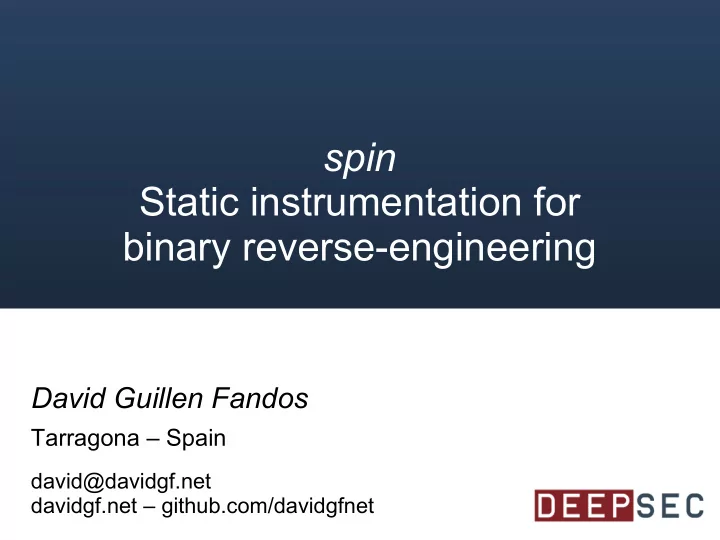

spin Static instrumentation for binary reverse-engineering David Guillen Fandos Tarragona – Spain david@davidgf.net davidgf.net – github.com/davidgfnet
Reverse-engineering ● What are we talking about? – Discover how a software program works – Figure out what it does ● Typically done using disassembler/debugger Nothing new here!
Reverse-engineering Sounds easy right?
Reverse-engineering ● Debugging/reading assembly can be tedious – In fact it's boring ● In the past assembly was written by humans Now compilers do all the work!! ● It's difficult to read their machine code but... ● They are predictable, respect call conventions and interfaces...
Reverse-engineering So... Why don't we take advantage of this to ease our lives? Could we do automatic-reverse engineering? Let machines do all work!
Automatic reverse-engineering ? ● Is it even possible? ● How much automatic is it? ● Can it replace a 'human'? Machines, you know...
Automatic reverse-engineering ! ● Let's create a tool that does all the dirty job we usually do by hand! ● How? Let's use binary instrumentation Wait, what da heck is binary instrumentation?
Binary instrumentation 101 ● Binary instrumentation is a technique which allows to modify and rewrite existing binaries – We can modify their behavior at runtime – Typically used in a non-intrusive way: just analyze the program – At assembly level: cannot reverse to high level languages ● Many tools available: Pin, DynamoRIO, Valgrind ...
Binary instrumentation 101 ● Works by injecting instructions in the original code ... mov edi, esi – Rewrites code on lea (esi,eax,4), ecx call instrument_func_pre demand mov edi, (ecx) – Similarly as Virtual mov (ecx+4), edi inc edi Machines do call instrument_func_pre ● It is possible to add user mov edi, (ecx+4) ... code on instruction basis, basic block, etc. x86 example: instrument all memory stores ( added instructions in red)
Binary instrumentation 101 ● What industry and professionals use binary instrumentation for? – Performance evaluation – CPU emulation – Tracing and profiling – Many others... ● What do we use it for...?
Binary instrumentation 4 hackers ● How can we use it for our purposes? – Create complex conditional breakpoints ● Just like debugger does, evaluate something and trigger 'break' ● This is cool cause debuggers usually only do stateless conditions – Create app tracing/logging outputs ● Dump any interesting info to a file ● We can also conditionally dump interesting info – Modify the application behavior ● We can modify memory and registers
Binary instrumentation 4 hackers ● Let's try to think as if we were the App coder ● We probably want to work on function basis – Look for relevant functions ● By using complex breakpoints (retaining status across executions) it is possible to characterize functions ● We can have a look at the stack too! – Generate some log with this info ● We can discard 99% of “boring” functions in the binary I wrote my own tool to do some of this...
Spin: Static instrumentation ● A tool for instrumenting at function granularity – Runs in application virtual memory space – Allows us to receive function parameters – Optionally we can modify return values – We rely on compilers respecting calling conventions (true for C/C++)
Spin: Static instrumentation ● Works by patching ... call instructions push 0x67 push eax – Only support for call 0x4013742 add esp, 8 immediate encoding ... – This way the ... instrumentation is push 0x67 static push eax call 0xac00de0 – Similar same add esp, 8 principle as DLL ... hooking
Spin: Static instrumentation ● Calls get redirected Target App. to user defined MyApp.exe functions – DLL injection patches Somelib.dll – It is possible to hook/dehook specific instructions or areas spin.exe – Choose modules to injects patch (avoid patching Spin.exe Spin.dll system/standard libs)
Spin: Static instrumentation Caller push 0x67 user callback push eax Global mutex lock call 0x4013742 Save context add esp, 8 void myfnc(...) { ... } Callee push ebp Lookup original callee ... Restore context ret Global mutex release
Demo time! ● This demo is just for “educational purposes”
Practical instrumentation What we saw: – Function recognition ● Based on stack parameters – Assume “strcmp”-like function is being used and look for it – Accounting ● Data logging for later analysis – Actuation ● Modify behavior on the fly – Just a matter of changing return value. Function is nullified.
Advanced instrumentation Show me more! What else can we do? – Advanced object analysis: Dump data from C++ objects and C/C++ structs – De-instrument uninteresting functions ● The overhead is noticeable ● This can be tricky, we don't want to lose data! – Look for patterns across calls ● Usually is more interesting to locate some functions for later analysis than trying to get the good one ● I told you! It's not 100% automatic!
Example: std::string ● Analyze function parameters containing std::string objects – Important things to know: compiler, libraries ... – In our example: ● MSVC compiler: Uses ECX as 'this' pointer ● MSVC stdlib: Stores short strings in place, large strings in heap. Pointer at +4 offset. – Others: Ability to inject tool at startup Skipping demo for this one, sorry :(
Example: dynamic dehooking ● Analyzing function calls can be slow. ● Idea: remove hooks from uninteresting functions – Simple way to do it: create a criteria and dehook functions matching/not matching it – More complex: Retain some status ● Remove functions which do not match some conditions many times Go demo go!
Conclusions ● It is possible to automate some reverse- engineering methodologies ● 'Smart' enough to be used in production ● But where is the limit? – The tool is far from perfect – Not suitable for API hooking – Protected/obfuscated sources will kick us I built myself a nice browser form grabber :D
Q&A Thank you! Questions?
Recommend
More recommend